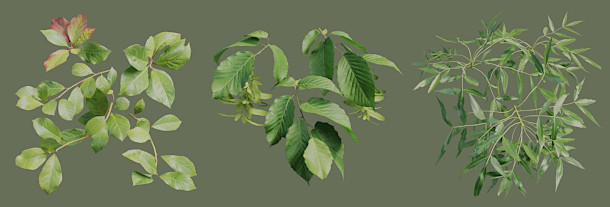The Grove Release 10a is now shipping
Originally posted on 7 April 2021. Scroll down for news of the Release 10a update.
F12 – aka developer Wybren van Keulen – has shipped The Grove Release 10, the latest version of his Blender-based tool for generating biologically plausible tree models.
The update, described as The Grove’s “biggest release ever” overhauls the software’s UI, adding a set of intuitive radial widgets, and makes it possible to add branches to a tree by sketching directly in the viewport.
Mimic the growth forms of real trees
The Grove takes a parametric approach to generating trees, with controls that mimic the factors determining the forms of real plants, resulting in more realistic-looking models.
Once the overall form of a tree has been set, The Grove fills in details by using ‘Twigs’: instanced geometry representing not only actual twigs, but leaves, flowers and fruit, sold separately to the core app.
The software is a Blender add-on, but the resulting textured geometry can be exported in standard file formats, including FBX and OBJ, for use in other DCC applicaitons.
Users can also generate wind and growth animations for trees, which can be exported in Alembic format.
Release 10: new, more touchscreen-friendly UI design
Release 10 overhauls The Grove’s interface, introducing a new UI design based on radial widgets, intended to provide a more intuitive workflow even when working on touchscreen devices.
It’s better to see it than to read about it, so check out the videos in the online release notes, but it’s been implemented right through the software.
Individual widgets let you bend or prune the branches of a tree, turntable-rotate the entire tree model, and even plant clumps of trees or set up wind animations.
There is also a new option to grow new branches by drawing strokes in the viewport to control their form, as shown in the video at the top of this story.
It’s one of The Grove’s few features not based on strict biological principles, and while it can be used to sketch out entire new trees, it’s mainly intended for art-directing the output of the existing tools.
New systems for simulating the effects of age, damage, gravity and self-shading
The update also modifies The Grove’s tree growth algorithms, adding new systems for simulating the deadwood that forms as trees age, and regenerative shoots caused by pruning or natural damage.
There are also updates to the way that the software simulates the response of trees to gravity, and the effect that the shade cast by the leaves on one branch has on the growth of surrounding branches.
As usual, the release notes provide a very clear summary of both the way the new tools are implemented and their underlying biology, so you can geek out over the details via the link below.

Updated 31 January 2022: The Grove Release 10a is shipping. (Full disclosure: it was released last September, but we didn’t spot it at the time.)
It’s primarily a bugfix and compatibility update, but it also improves performance significantly: the release notes estimate that the update “saves an average of 25% of simulation time” per tree.
F12 has also released 11 new Twigs for the software.
Pricing and availability
The Grove Release 10a is available for Blender 2.80+, running on Windows, Linux and macOS.
The base application has an MSRP of €139 (around $155), up from €119 since Release 10. Individual Twigs cost €9 ($10), down slightly since Release 10.
Read a full list of new features in The Grove on the product website
